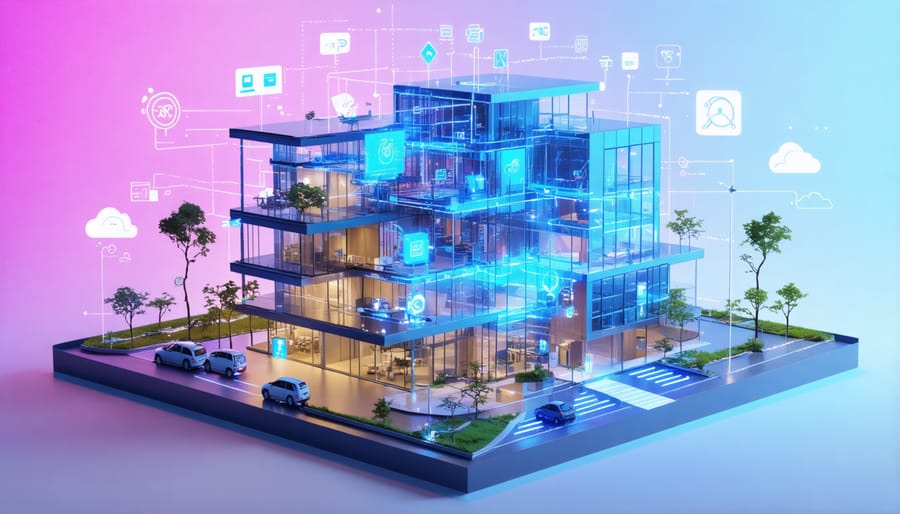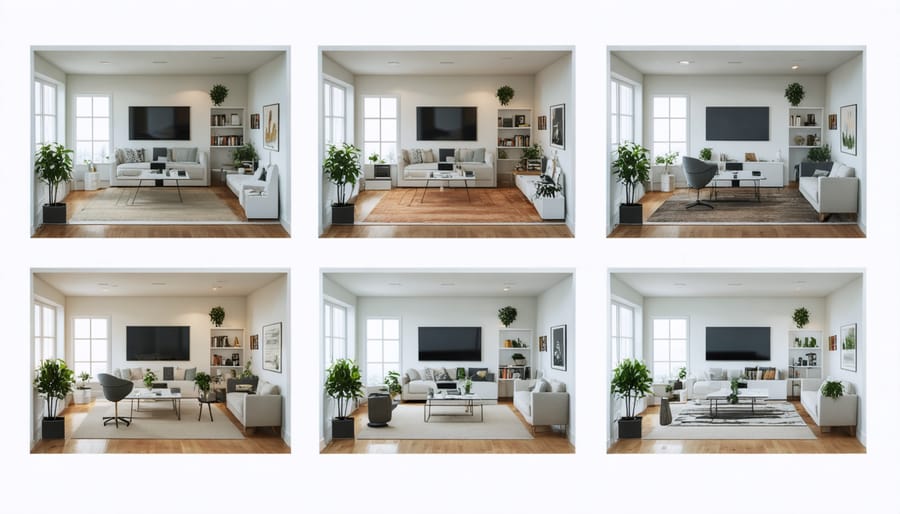Adaptive design revolutionizes construction by responding dynamically to evolving human needs, environmental conditions, and technological advancements. This sophisticated approach transcends traditional static design methodologies, enabling buildings and spaces to transform over time while maintaining optimal functionality and user experience.
At its core, adaptive design represents a paradigm shift in architectural thinking, integrating flexibility, modularity, and future-readiness into every aspect of the built environment. It encompasses both physical adaptability—through movable elements, convertible spaces, and modular components—and technological adaptability, incorporating smart systems that respond to usage patterns and environmental changes.
Industry professionals increasingly recognize adaptive design as essential for creating resilient, sustainable structures capable of meeting tomorrow’s challenges. From healthcare facilities that can rapidly reconfigure during public health crises to office spaces that seamlessly transition between collaborative and individual work modes, adaptive design principles ensure buildings remain valuable and functional throughout their lifecycle.
This comprehensive examination explores the fundamental principles, implementation strategies, and real-world applications of adaptive design, providing construction professionals with actionable insights for creating future-proof spaces that enhance human experience while maximizing return on investment.
The Evolution of Adaptive Design in Architecture
From Static to Dynamic: The Paradigm Shift
The evolution of building design has witnessed a remarkable transformation from rigid, predetermined structures to adaptable, responsive environments. Traditional architectural approaches relied on fixed solutions that remained unchanged throughout a building’s lifecycle, often leading to premature obsolescence and costly renovations. This static paradigm, while providing stability, failed to address the dynamic nature of human needs and organizational changes.
Today’s construction industry recognizes that buildings must evolve alongside their occupants. Modern adaptive design principles embrace flexibility through modular components, movable partitions, and reconfigurable spaces. This shift has been accelerated by technological advancements, changing workplace dynamics, and the growing emphasis on sustainability.
The transition from static to dynamic design thinking represents more than just a technical evolution; it embodies a fundamental change in how we perceive built environments. Buildings are no longer viewed as finished products but as living systems capable of transformation. This approach not only extends a structure’s functional lifespan but also optimizes resource utilization and enhances user satisfaction through responsive environmental solutions.
Leading architects and engineers now prioritize adaptability from the earliest stages of design, incorporating systems and materials that facilitate future modifications without compromising structural integrity or operational efficiency.

Key Principles of Modern Adaptive Design
Modern adaptive design is anchored in several fundamental principles that guide the evolution of spaces to meet changing needs. At its core lies the integration of human-centric design approaches, ensuring spaces remain responsive to occupant requirements while maintaining structural integrity.
Flexibility serves as the primary principle, incorporating modular elements and reconfigurable systems that allow spaces to transform without major reconstruction. Sustainability follows closely, emphasizing resource efficiency and the ability to adapt without generating excessive waste. The principle of technological integration enables smart systems that can monitor and respond to usage patterns, environmental conditions, and occupant behaviors.
Scalability ensures that designs can accommodate growth or contraction without compromising functionality. This is complemented by the principle of resilience, which focuses on creating structures that withstand both physical and functional obsolescence. Universal accessibility remains paramount, ensuring adaptations serve diverse user groups effectively.
These principles work in concert to create buildings that evolve organically with changing needs while maintaining operational efficiency and user comfort.
Technology and Systems in Adaptive Design
Smart Building Systems
Modern adaptive design heavily relies on smart building systems that seamlessly integrate Internet of Things (IoT) devices and automated controls. These systems form the technological backbone of adaptive buildings, enabling real-time responses to environmental changes and occupant needs.
Core components typically include sensor networks monitoring occupancy patterns, temperature variations, lighting conditions, and air quality. Advanced Building Management Systems (BMS) process this data through sophisticated algorithms, automatically adjusting HVAC systems, lighting controls, and security protocols to optimize building performance and occupant comfort.
The integration extends to predictive maintenance capabilities, where AI-powered systems anticipate equipment failures before they occur, reducing downtime and maintenance costs. Energy management becomes more precise through automated load-balancing and demand-response systems, which adjust power consumption based on real-time utility rates and building usage patterns.
Recent innovations include behavioral learning algorithms that adapt to occupant preferences over time, creating personalized environments for different zones within the building. These systems can recognize patterns in space utilization, automatically adjusting ventilation rates and temperature settings to match actual usage rather than predetermined schedules.
For facility managers and building operators, these integrated systems provide comprehensive dashboards and analytics tools, enabling data-driven decisions about building operations and future adaptations. This technological framework ensures that adaptive buildings remain responsive to changing needs while maintaining optimal efficiency and occupant comfort.

Modular and Flexible Components
Modular and flexible components form the cornerstone of adaptive design implementation, enabling spaces to transform efficiently according to evolving needs. These elements typically include movable walls, reconfigurable furniture systems, and plug-and-play infrastructure that can be easily modified without major construction work.
Key physical components often incorporate sliding or folding partition systems that allow rapid space division or combination. These systems utilize advanced track mechanisms and acoustic materials to maintain functionality while ensuring privacy and sound isolation when needed. Raised access flooring systems provide additional flexibility by creating serviceable channels for electrical, data, and mechanical systems that can be readily accessed and modified.
Furniture solutions play a crucial role, featuring adaptable workstations, modular storage units, and multi-functional pieces that can serve various purposes. These components often integrate power and data connectivity, supporting technological requirements while maintaining mobility.
Ceiling systems also contribute to adaptability through modular grid designs that accommodate changing lighting, HVAC, and other overhead service requirements. Modern adaptive designs frequently incorporate demountable wall systems that can be disassembled and reconstructed without damage, reducing waste and supporting sustainable practices.
Infrastructure components such as flexible HVAC zonation and modular electrical systems ensure that mechanical and electrical services can adapt to new space configurations while maintaining optimal performance. These systems often feature quick-connect components and standardized interfaces that facilitate modifications without extensive downtime.
Human-Centric Design Considerations
Workplace Evolution
Adaptive design has become increasingly critical in addressing evolving work patterns and the transformation of traditional office environments. The modern workplace demands flexibility to accommodate hybrid work models, collaborative spaces, and individual focus areas within the same footprint.
Contemporary adaptive design solutions incorporate modular elements and movable partitions that can quickly reconfigure spaces based on immediate needs. These features allow organizations to adjust their physical environment without costly renovations, supporting both impromptu team collaborations and private work sessions.
Technology integration plays a crucial role in adaptive workplace design, with infrastructure that supports seamless transitions between different work modes. Smart building systems, adjustable lighting, and mobile furniture solutions work in concert to create environments that respond to occupancy patterns and user preferences.
The COVID-19 pandemic has accelerated the adoption of adaptive design principles, highlighting the importance of spaces that can rapidly transform to meet changing health and safety requirements. Design elements now routinely include improved ventilation systems, touchless interfaces, and flexible spacing options that can expand or contract based on social distancing needs.
Successful adaptive workplace design also considers future scalability, incorporating elements that can evolve with organizational growth and technological advancement. This forward-thinking approach ensures that investments in workplace modifications deliver long-term value while supporting immediate operational requirements. The result is a more resilient built environment that can withstand and adapt to future disruptions while maintaining productivity and employee well-being.
Residential Adaptability
Residential adaptability represents a cornerstone of modern architectural design, addressing the dynamic nature of household needs throughout different life stages. This approach encompasses flexible floor plans, modular components, and universal design principles that allow homes to evolve with their occupants’ changing requirements.
Key features of adaptable residential design include moveable walls, multi-purpose spaces, and pre-planned expansion capabilities. These elements enable homeowners to modify their living spaces without substantial structural alterations. For instance, a home office can transform into a nursery, or a ground-floor bedroom can be adapted for aging-in-place scenarios.
Infrastructure considerations play a crucial role in residential adaptability. This includes strategic placement of electrical outlets, plumbing rough-ins, and load-bearing walls to accommodate future modifications. Smart home technology integration points should be incorporated during initial construction to facilitate future technological upgrades.
According to industry research, homes designed with adaptability principles demonstrate 30% longer functional lifespans and maintain higher market values compared to traditional fixed-layout residences. This approach not only benefits homeowners but also contributes to sustainable construction practices by reducing the need for major renovations or relocations.
Successful implementation requires careful consideration of:
– Flexible utility systems
– Accessible design features
– Modular storage solutions
– Convertible room configurations
– Future-proof technology infrastructure
Professional architects and builders increasingly recognize that residential adaptability isn’t merely about immediate functionality but about creating homes that can seamlessly accommodate lifestyle changes, family growth, aging populations, and evolving work patterns. This forward-thinking approach ensures long-term value and sustainability in residential construction.

Implementation Challenges and Solutions
Cost Considerations
The financial implications of implementing adaptive design require careful consideration, as initial costs often exceed traditional construction approaches. However, the long-term return on investment (ROI) typically justifies the upfront expenditure through reduced renovation needs and extended building lifespan.
Initial costs primarily stem from specialized design services, flexible building systems, and modular components. These elements can increase project budgets by 10-15% compared to conventional construction. However, studies indicate that buildings with adaptive design features demonstrate 20-30% lower lifecycle costs over a 30-year period.
Key cost considerations include:
– Design fees for specialized architectural and engineering services
– Premium materials and systems that enable flexibility
– Modular infrastructure components
– Advanced technological integration
– Higher-grade structural elements to accommodate future modifications
The ROI manifests through:
– Reduced renovation and reconstruction costs
– Lower vacancy rates due to easier space adaptation
– Decreased downtime during modifications
– Enhanced property value due to versatility
– Extended building lifespan
– Lower environmental impact and associated costs
To optimize cost-effectiveness, stakeholders should conduct thorough lifecycle cost analyses during the planning phase. This evaluation should consider both immediate construction expenses and long-term operational savings. Additionally, phasing adaptive features strategically can help manage initial costs while maintaining future flexibility.
Insurance companies and lenders increasingly recognize the value of adaptive design, often offering preferential rates for buildings incorporating these principles, further enhancing the financial benefits.
Technical Integration
Successfully implementing adaptive design requires careful consideration of technical challenges and integration strategies. Building systems must be designed with flexibility and scalability in mind, incorporating modular components that can be easily modified or replaced as needs change.
Key technical considerations include designing adaptable structural systems that can accommodate future modifications without compromising integrity. This often involves utilizing column-free spaces, raised floors for easy access to utilities, and demountable partition systems. Engineers must ensure that mechanical, electrical, and plumbing systems have sufficient capacity and accessibility for potential modifications.
Digital modeling and Building Information Modeling (BIM) play crucial roles in planning adaptive spaces. These tools help visualize different configuration scenarios and identify potential conflicts before construction begins. Integration of smart building technologies and sensors can provide valuable data about space utilization and environmental conditions, informing future adaptations.
Construction professionals should pay special attention to connection details and material selection. Using standardized components and connection methods facilitates future modifications while maintaining quality and safety standards. Documentation of as-built conditions and maintaining detailed records of building systems is essential for successful long-term adaptability.
Coordination between different trades and disciplines during both design and construction phases is critical. Regular communication and clear documentation help ensure that adaptive features are properly implemented and maintained throughout the building’s lifecycle.
Adaptive design has emerged as a crucial paradigm in modern construction and architecture, fundamentally reshaping how we approach building projects. Through our examination, we’ve seen how this methodology enables structures to evolve with changing human needs while maintaining functionality and sustainability. The integration of flexible spaces, modular components, and smart technologies has proven essential in creating buildings that stand the test of time.
Looking ahead, adaptive design will become increasingly vital as urbanization accelerates and environmental challenges intensify. The construction industry must prepare for greater emphasis on convertible spaces, sustainable materials, and digital integration. Emerging technologies like AI and IoT will further enhance our ability to create truly responsive environments that adapt to occupant needs in real-time.
The success of adaptive design relies heavily on collaboration between stakeholders, from architects and engineers to facility managers and end-users. As demonstrated through numerous case studies, projects that embrace adaptive principles consistently deliver superior long-term value and user satisfaction. The future will likely see more stringent regulations and standards around adaptability in building codes, making it essential for industry professionals to stay informed and prepared.
For construction professionals, mastering adaptive design principles is no longer optional but a fundamental requirement for creating resilient, future-proof buildings. The investment in adaptable solutions today will yield significant returns through reduced renovation costs, improved occupant satisfaction, and enhanced building longevity tomorrow.

